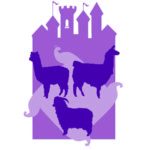This blog entry arose from a good fiber friend and client, Judy Higgs. She happened to be over picking up some new roving, and she showed me some of her most recent hand spinning. As soon as we put it onto the table there were so many interesting things to note and conversation followed.
Take a look at the fuzzy mint green bit of roving in the center of the picture, its pretty light and fluffy. Now compare it to first the bobbin with singles on it and then the bobbin where it has been plied on itself and then the bobbin where it was plied with a multi-navy colored roving. The shade and brightness of this particular green roving changes. We were amazed at that!
It was both Judy’s and my conclusion that as the roving was worked it got lighter and brighter, once as a single and then a bit more plied on itself. In real life the original roving had a foggy, misty almost even gentle gray quality within the green. On the first bobbin as a single, it lightens and brightens quite a bit, and in real life a bit more as a plied yarn.
It is worth noting that all roving goes through some Visual Change as it is spun. But often – – perhaps even most of the time, the change is to get darker and more intense. When you are looking at roving, compared to yarn, the color is lacy, more spread out and airy. The viewer looks right through it to some degree. Just compacting the fibers and removing all the airspace when spinning, means that as a single you are looking more purely at just what the dyed fiber really is. The usual experience of the fiber getting darker and more intense is from the light and air in between fibers being subtracted as it turns into a single.
A change in the behavior of the color that you might notice from a single to a plied yarn – when the example is of a basically solid color – could be explained by the fact that the plied yarn has more surface area for your eye to take in the color. So, its not that the color so much was altered, but rather that you could get a better look-see at it!
Changes in particular colors inside a multi-colored roving when spun & plied OR changes in roving color when two different rovings are plied with each other are much more the same issue. Part of how we see color, or more accurately part of how our brain interprets color is due to the fact that we see color in context of other color. So we are always determining color not just on what we assign it on its own, but its value in context of the environment – – this could mean everything from the table cloth (immediate physical surrounding), the lighting, and importantly even our own mood and level of focus.
However, our little mint green roving was very consistent in its behavior all the way through this artistic experiment, as it remains very light and bright even when plied next to the multi-colored navy blue roving in the picture. That was absolutely not a guarantee. By placing the green next to a blue, they could have looked more like each other as they often do, in this case, the mint still pops.
All of these factors are places where your own artistic critique will come into play. For example: What pleases you. What surprises you which could mean unexpected disappointment or pleasure. And, as always the satisfaction you get when your prediction is correct.
Judy’s final piece of the experiment was to see it knit – note the swatch in the picture too. Not everyone is a swatcher, but in this case it really completes the color experiment. You can see all the variations on a color theme and interest that can be created in the final knit project by observing these same kinds of things in your own handspun yarns. Be adventurous, creative, and experimental. Then look back, make observations, and enjoy your work!

